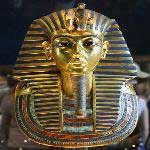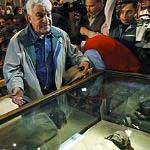
The DNA testing of several prominent Egyptian mummies has revealed the identities of the mother and the father of famous boy king Tutankhamun. Egypt's head of antiquities, Zahi Hawass, says tests also revealed what killed Tut.
Egyptian antiquities chief Zahi Hawass says the results of two years of tests on famous Egyptian mummies show boy king Tutankhamun died of malaria.
Speculation Tut was murdered was debunked by the exhaustive scientific investigation. Hawass says a series of CAT scans revealed damage to Tut's head was just part of the mummification process.
"The important thing is how King Tut died. Everyone thought in the past that King Tut was murdered because of the blow on the back of the head. But, the study of the CAT-scan machine proved that the blow at the back of the head was opened to put the liquid for mummification," he said.
Hawass emphasizes the mystery over King Tut's family tree began with questions about seven unidentified mummies at the Egyptian museum.

Hawass says the tests identified the mummies found in the tomb with King Tut as his father Akhenaten and his grandmother, Tiye. A third mummy is thought to be King Tut's mother.
Researcher Albert Zink of the Institute for Mummies and the Iceman in Bolzano, Italy says the main conclusion of the lengthy DNA testing was to have pinned down the identities of Tut's parents:
"The main conclusion was that we identified the parents of Tutankhamun: the father which is actually Akhenaten and the mother, which is the younger lady mummy, which we do not know up to now whether she is Nefertiti or ... one other person and we identified that he actually suffered from a severe form of malaria and maybe this could have caused death," said Zink.
Hawass points out King Tut was a sickly man, with a cleft palate and a club foot, which forced him to walk with a cane. He attributes Tut's health problems to genetic deformations caused by the marriage of his father Akhenaten to his sister, the younger lady mummy, whose name is not known.
The findings of the Egyptian Mummy Project, which took two years to complete, are being published by the Journal of the American Medical Association (JAMA).
Hawass tells VOA that two things in the study amazed him most:
"What really moved me the most: two things. Number one is the discovery of Akhenaten's mummy and to find out that he has no Marfan's (syndrome), he had no deformities, he was a normal man," he said. "He did not have features like you see in the statues ... features of a man and a woman; and the second thing is the cause of his death. How did King Tut die? That really amazed me a lot," Hawass said.
Some statues of Akhenaten and other Egyptian pharaohs of the 18th dynasty possess both male and female characteristics. This, argues Hawass, was simply an attribute that was added to the statues to "confer fertility on the pharaohs," which were "thought to be gods."
Although DNA testing revealed which mummies were the parents of King Tut, the remaining mystery involves the name of Tut's mother. Hawass notes that archeologists must still pin down the name of the "younger lady" mummy which was genetically found to be his mother.
debunk: to show that an idea, a belief, etc. is false; to show that something is not as good as people think it is 批判;驳斥;揭穿…的真相
cleft palate: a condition in which somebody is born with the roof of their mouth split, making them unable to speak clearly 腭裂
club foot: a foot that has been deformed(= badly shaped) since birth (先天性的)畸形足
Marfan's syndrome: a genetic disorder of the connective tissue 马凡氏综合症
In Egypt, King Tut's tomb getting a makeover
(来源:VOA 编辑:陈丹妮)
